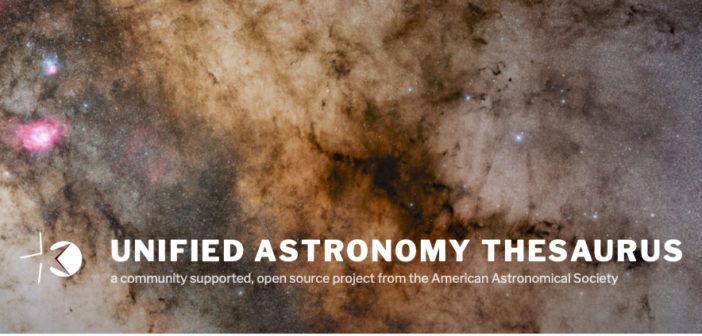If you’ve submitted an article to AAS journals recently, you may have noticed that our historical subject keywords have been replaced with something new: Unified Astronomy Thesaurus (UAT) terms.
What is the UAT, and why does it matter? We sat down with Katie Frey (Wolbach Library, Center for Astrophysics | Harvard & Smithsonian), UAT curator, to find out.
Out With the Old
Broadly speaking, the UAT is an effort to unite all astronomers under a single evolving vocabulary that governs keywords and classification for astronomy research. The UAT replaces the old AAS subject keywords, which hadn’t been updated in many years.
But the UAT is more than just a new list of keywords, according to Frey. “A lot of people think a thesaurus means just alternate ways of saying the same word, but the real technical definition of a thesaurus is a hierarchical structure.”

You can explore the UAT visually using this neat sorting tool. [UAT]
Unifying Resources
One benefit to the UAT is that it’s not only being used by the AAS journals. The goal of the Thesaurus is cross-program adoption, Frey says.
Early adopters of the UAT include the AAS, the Astrophysics Data System (ADS), and the International Virtual Observatory Alliance (IVOA), as well as the Space Telescope Science Institute (STScI) supported proposal system for the Hubble Space Telescope.
Frey hopes that, once established, the UAT will be further adopted by other astronomical publishers, observatories, astronomical databases like SIMBAD and NED, astronomical conferences, and more. When all astronomy resources are linked by a common identification system like the UAT, users will be able to access a wealth of information about an astronomical concept in a clear and central way.
A Living Framework
The UAT uses unique identifiers — rather than words — for concepts. One reason for this is that it allows translation of a concept into another language: “dark matter (353)” is the same identifier as “暗物质 (353)”, for instance. But another reason is because it allows the UAT to evolve over time.

Galaxy or nebula? There was a time when astronomers didn’t know the answer. [NASA/ESA/Hubble Heritage Team (STScI/AURA)]
Frey cites the example of a historical term, “gaseous cloud”, which astronomers once used to refer to objects we now identify as either “nebulae” or “galaxies”. Within the framework of the UAT, a historical article tagged with the identifier “gaseous cloud” can be correctly linked to more recent articles that use modern terms, whereas a simple static keyword structure would lose that connection.
The Thesaurus is managed from a GitHub repository where users can submit issues as they see concepts or relationships missing or mis-categorized. Frey encourages back-and-forth discussion about concepts in GitHub comments, with the goal of keeping the UAT’s structure transparent and public. She plans to issue a new release of the UAT roughly once a year.
How You Can Help
If you’re an author with AAS journals, Frey encourages you to think about your keywords before it’s time to submit your article! The UAT’s living structure relies on experts like you to make suggestions for changes, and it takes time for those to push through. You can check now to see if your field is well-described by using one of the following tools to explore the UAT:
UAT alphabetical browse
UAT hierarchical browse
UAT visual sorting tool
If you find anything that needs updating, you can submit an issue on GitHub or contact Katie Frey directly.
Happy categorizing, and here’s to hopes of a unified organization for astronomy in the future!
Background image in the UAT cover photo credited to ESO/S. Guisard.


2 Comments
Pingback: Allgemeines Live-Blog ab dem 15. Dezember | Skyweek Zwei Punkt Null
Pingback: Update from the Unified Astronomy Thesaurus